|
Sunday:
November 3, 2002 | |
0017 GMT |
 |
Stardust zooms past asteroid Annefrank
NASA's Stardust spacecraft successfully completed a close flyby of asteroid Annefrank early Saturday as an opportunity for a full dress rehearsal of procedures the spacecraft will use during its Jan. 2, 2004, encounter with it primary science target, comet Wild 2.
 FULL STORY FULL STORY
 |  |
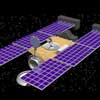
|
 |
In search of cosmic mayhem
A physicist at Washington University in St. Louis working with scientists at the Smithsonian Institution is unveiling the dark, violent side of the universe. Studying the highest energy photons known to science, the team is analyzing bursts of gamma rays released from massive black holes at the center of so-called active galaxies.
 FULL STORY FULL STORY
 |  |

|
 |
|
Saturday:
November 2, 2002 | |
0131 GMT |
 |
Saturn-bound Cassini probe sees its destination
Saturn appears serene and majestic in the first color composite made of images taken by NASA's Cassini spacecraft on its approach to the ringed planet, with arrival still 20 months away. The planet was 177 million miles away from the spacecraft, nearly twice the distance between the Sun and Earth, when Cassini took the images.
 FULL STORY FULL STORY
 |  |
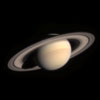
|
 |
Kuiper Belt implicated in cosmic rays mystery
A team led by Southwest Research Institute has found that a portion of anomalous cosmic rays -- charged particles accelerated to enormous energies by the solar wind -- results from interactions with dust grains from a belt of comet-sized objects near Pluto's orbit.
 FULL STORY FULL STORY
 |  |

|
 |
Magnetism shapes beauty in the heavens
Observations by a international team of astronomers suggest a solution to the long outstanding problem as to how, at the end of their lives, a perfectly spherical star can give rise to the complex and often far from spherical structure seen in the resulting planetary nebula - some of the most beautiful objects in our heavens.
 FULL STORY FULL STORY
 |  |

|
 |
|
Friday:
November 1, 2002 | |
0900 GMT |
 |
Soyuz docks to station; Shuttle to launch Nov. 11
With smooth precision, a new Soyuz spacecraft docked with the international space station at 12:01 a.m. EST today, giving the lab's full-time crew a fresh lifeboat to replace an aging spacecraft nearing the end of its certified 200-day orbital lifetime. Meanwhile, NASA managers met Thursday and set Nov. 11 as the official launch date for Endeavour's upcoming mission to the station.
 FULL STORY FULL STORY
 SOYUZ DOCKING TIMELINE SOYUZ DOCKING TIMELINE
 EARLIER LAUNCH STORY EARLIER LAUNCH STORY
 |  |

|
 |

Video coverage for subscribers only:
 VIDEO:
DOCKING AS SEEN BY CAMERA ON THE SOYUZ QT or RV VIDEO:
DOCKING AS SEEN BY CAMERA ON THE SOYUZ QT or RV
 VIDEO:
VIEW FROM STATION'S S1 CAMERA OF DOCKING QT or RV VIDEO:
VIEW FROM STATION'S S1 CAMERA OF DOCKING QT or RV
 VIDEO:
TAXI CREW ENTERS STATION AFTER HATCH OPENING QT or RV VIDEO:
TAXI CREW ENTERS STATION AFTER HATCH OPENING QT or RV
 VIDEO:
LAUNCH OF THE SOYUZ ROCKET QT or RV VIDEO:
LAUNCH OF THE SOYUZ ROCKET QT or RV
 SUBSCRIBE NOW SUBSCRIBE NOW

|
Solid-fueled booster a step closer to Atlas 5 use
The redesigned Atlas 5 solid rocket booster has passed the first of two qualification test firings, giving Lockheed Martin officials confidence the new Aerojet-made motor will be ready for launches starting early next year.
 FULL STORY FULL STORY
 |  |
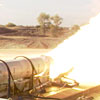
|
 |
Energized 'heartbeats' may explain stirred up galaxies
Until now, astronomers haven't been able to offer a full explanation for why the Milky Way and other galaxies produce new stars at a relative snail's pace. While they have known for decades that high turbulence keeps huge clouds of hydrogen gas from condensing into stars, they haven't identified all the causes of the galactic perturbations.
 FULL STORY FULL STORY
 |  |
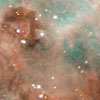
|
 |
|
Thursday:
October 31, 2002 | |
0225 GMT |
 |
Red freckles on Europa suggest 'lava lamp' action
Reddish spots on the icy surface of Jupiter's moon Europa may indicate pockets of warmer ice rising from below. This upwelling could provide an elevator ride to the surface for material in an ocean beneath the ice, say scientists studying data from NASA's Galileo spacecraft.
 FULL STORY FULL STORY
 |  |
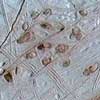
|
 |
Satellite sees 200-mile ash, smoke plume from Mt. Etna
New satellite pictures from NASA show the dark brown smoke and ash plume originating from Mt. Etna stretching for hundreds of miles over the Mediterranean Sea. NASA's Terra satellite captured spectacular true-color images of the eruption. A long, grayish-brown plume of ash and smoke is streaming southward from the volcano.
 FULL STORY FULL STORY
 |  |
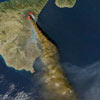
|
 |
'Earthshine' used to find life on Earth
Now that the discovery of extrasolar planets, or planets around distant stars, has become relatively routine, scientists are now tackling the next step: finding life-bearing worlds. To do this, observers must know what signs to look for in the feeble light from these faraway planets.
 FULL STORY FULL STORY
 |  |

|
 |
|
Wednesday:
October 30, 2002 | |
0442 GMT |
 |
GPS launch on hold after Delta 2 rocket damaged
A Boeing Delta 2 rocket was damaged in a freak accident last week as workers attached a Global Positioning System satellite to the booster at Cape Canaveral's launch pad 17B. The mishap will delay GPS launch at least a month and has the potential of also pushing back the January launch of NASA's fourth Great Observatory.
 FULL STORY FULL STORY
 |  |

|
 |
Soyuz taxi crew launches
A new Soyuz lifeboat for the international space station was successfully launched Tuesday from the Baikonur Cosmodrome in Kazakhstan. Carrying two Russian cosmonauts and a Belgian astronaut representing the European Space Agency, the Soyuz TMA spacecraft blasted off on time at 10:11 p.m. EST, rocketing away through heavy fog and quickly disappearing from view.
 FULL STORY FULL STORY
 SOYUZ DOCKING TIMELINE SOYUZ DOCKING TIMELINE
 |  |

|
 |

Video coverage for subscribers only:
 VIDEO:
SOYUZ ROCKET BLASTS OFF QT or RV VIDEO:
SOYUZ ROCKET BLASTS OFF QT or RV
 SUBSCRIBE NOW SUBSCRIBE NOW

|
Galileo nears first visit to small moon, dusty ring
Before starting its 35th and final orbit around Jupiter next week, NASA's Galileo spacecraft will visit three intriguing features of the giant planet's neighborhood for the first time: a small moon named Amalthea, a dusty ring and the inner region of Jupiter's high-energy magnetic environment.
 FULL STORY FULL STORY
 |  |

|
 |
|
Tuesday:
October 29, 2002 | |
0148 GMT |
 |
Engineers study glitch in shuttle firing circuit
NASA and contractor engineers are working "around the clock" to find out why one of two circuits used to detonate the massive bolts holding the shuttle Atlantis to the launch pad failed to fire earlier this month. The issue must be resolved before Endeavour can be cleared for launch next month.
 FULL STORY FULL STORY
 |  |

|
 |

Video coverage for subscribers only:
 VIDEO:
FOOTAGE OF HOLD-DOWN POST RELEASING SHUTTLE QT or RV VIDEO:
FOOTAGE OF HOLD-DOWN POST RELEASING SHUTTLE QT or RV
 SUBSCRIBE NOW SUBSCRIBE NOW

|
NASA funds next phase for planet-finding satellite
NASA awarded a contract Monday, with a potential value of $28.4 million, to Ball Aerospace and Technology Corp. for development of the optics and detectors for a high-tech camera for the Kepler planet-finding spacecraft, scheduled for launch in 2007.
 FULL STORY FULL STORY
 |  |

|
 |
Orbital to build satellite for TELKOM of Indonesia
Orbital Sciences Corp. announced Monday that it has signed a major new contract in its geosynchronous communications satellite manufacturing business. Indonesia's state-owned telecommunications company, TELKOM, has ordered a C-band spacecraft for launch in late 2004.
 FULL STORY FULL STORY
 |  |
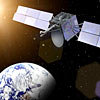
|
 |
|
Monday:
October 28, 2002 | |
1200 GMT |
 |
Soyuz, shuttle set for launch to space station
Engineers at the Kennedy Space Center are readying the shuttle Endeavour for launch Nov. 10 or 11 on a mission to deliver a fresh three-man crew and a 14.5-ton solar array truss segment to the international space station.
 FULL STORY FULL STORY
 PRELAUNCH VIDEO INDEX PRELAUNCH VIDEO INDEX
 |  |

|


 This exceptional chronicle of the historic Apollo 11 lunar landing mission features new digital transfers of film and television coverage unmatched by any other.
This exceptional chronicle of the historic Apollo 11 lunar landing mission features new digital transfers of film and television coverage unmatched by any other.